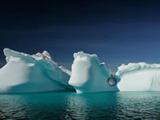


Five Berkeley Lab physicists have been named Fellows of the American Physical Society (APS) for 2009. Fellows are nominated by their APS colleagues, chosen by Fellowship committees within each APS division, and elected by the APS Council; fellowship is thus “a distinct honor signifying recognition by one's professional peers.” The Berkeley Lab five are (from l-r clockwise) Steve Gourlay of the Accelerator and Fusion Research Division (AFRD), Beate Heinemann of the Physics Division, Nu Xu of the Nuclear Science Division (NSD) Spencer Klein (NSD), and John Staples (AFRD). More>
 Research: Nuclear Science Division Heads Study of Quark-Gluon Plasma
Research: Nuclear Science Division Heads Study of Quark-Gluon PlasmaOn Dec. 14, the Department of Energy’s Office of Nuclear Physics announced funding for three “Topical Collaborations,” multi-institutional research projects of special interest to the nuclear science community. Berkeley Lab’s Nuclear Science Division (NSD) will lead Jet and Electromagnetic Tomography in Heavy-Ion Collisions (JET), a collaboration among three national laboratories and six universities. JET will use energetic quarks, gluons, and photons as probes to study collision-created quark-gluon plasmas “tomographically,” effectively slicing through the evanescent state to study it inside and out. NSD’s Xin-Nian Wang is principal investigator and co-spokesperson of JET, which will receive $2.5 million in DOE funding over five years. More>
 Research: Simulating Ion Beams
Research: Simulating Ion Beams The Neutralized Drift Compression Experiment II (NDCX-II) is an accelerator for delivering a high-current pulse of lithium ions to a foil target almost simultaneously, momentarily heating the target to a state known as warm dense matter. Designing this unusual accelerator to exacting specifications required extensive computer modeling, including animated simulations of the behavior of the ion beam under perfect and not-so-perfect conditions. More>
 Research: Simulation Links Warming Oceans and Subsea Methane
Research: Simulation Links Warming Oceans and Subsea MethaneA first-of-its-kind computer simulation that mirrors real-world observations of methane bubbling up from a seabed in the Arctic Ocean provides further evidence that warming oceans may unleash vast quantities of methane trapped in hydrate deposits buried beneath the seafloor. Methane is one of the most potent greenhouse gases. The simulations, conducted by Berkeley Lab scientists, focus on oceanic gas hydrates, which are solid crystalline compounds in seafloor sediment. Methane molecules are lodged within the compounds’ icy latticework. More>
 HR: Video of Post-Employment Benefits Forum Now Online
HR: Video of Post-Employment Benefits Forum Now Online Employees who missed the post-employment benefits forum that took place last Thursday can watch an archived video of the proceedings online. The forum, sponsored by the University of California, included a presentation on the fiscal challenges facing UC and how retirement and medical benefits may be affected as well as a question-and-answer session with Lab staff. The video lasts for about an hour and a half.
In anticipation of the holiday break, the Lab’s shuttle bus service will alter final departure times tomorrow:
Building 65 — 6 p.m. for the Blue Route; 5:40 p.m. for Rockridge Route
Building 62/66 — 5:50 p.m. for the Orange Route
Potter St. — 5:25 p.m.
JBEI — 5:35 p.m.
Lab staff are reminded that their December pay will not be distributed until Monday, Jan. 4.
Today at Berkeley Lab encourges comments, suggestions, and story ideas. Please send them here.
TABL is produced by Public Affairs' Communications Group